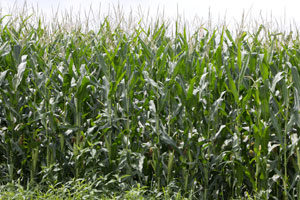Weather conditions in July (and earlier) in 2011 have been far from ideal in many areas. Planting was late in portions of the eastern and northern Corn Belt. Southern portions of the U.S. have experienced hot and generally dry conditions for an extended period. The central and northern growing areas have experienced widely varying weather conditions during planting and the early part of the growing season. These widely varying conditions have been reflected in the USDA’s weekly Crop Progress reports which report crop condition ratings. As of July 10, the lowest crop ratings were reported in Texas, North Carolina, Kansas, and Ohio. The highest crop ratings were in Iowa, Kentucky, Nebraska, and Tennessee.
The continuation of high temperatures in southern areas and the expansion of hot weather to much of the corn belt this week raises additional concerns about corn yield. The high temperatures in the Corn Belt are occurring during the reproductive stage for a large portion of the crop. There is some indication that the intense heat will begin to moderate in many areas by the upcoming weekend. Still, average July temperatures in the Corn Belt may rank among the highest since 1960. In addition to the high temperatures, corn yield potential may be threatened by the expanding area of dryness over the last few weeks. For the first half of July, precipitation was well below average in large portions of Illinois and Indiana. Portions of southeastern Iowa, northwest Ohio, and eastern Michigan have also been relatively dry. Precipitation over the past 30 days was below normal in large portions of Iowa, Illinois, Indiana, Ohio, Michigan, Pennsylvania, and southern Wisconsin.
Less than favorable July weather in many areas has reduced corn yield potential in those areas. The overall impact on the likely U.S. average corn yield will be influenced by weather conditions in the last week of July and in August. Some indication of the impact will be revealed in the weekly crop condition ratings. Overall ratings for the week ended July 17 may not decline substantially, but declines could be reported for the week ending July 24 as a result of high temperatures and the lack of widespread precipitation.
The importance of the 2011 U.S. corn yield is underscored by the USDA’s projection of record consumption of U.S. corn during the 2011-12 marketing year. The most recent projection, released on July 12, forecasts consumption at 13.5 billion bushels, 195 million bushels above expected consumption during the current marketing year. Stocks at the end of the 2011-12 marketing year are projected at 870 million bushels, or 6.4 percent of projected use. Based on the forecast of 84.9 million acres to be harvested, a yield below 156.5 bushels would force a reduction in the projected level of consumption. A continuation of relatively high livestock and ethanol prices, along with growing Chinese demand, suggests that high corn prices would be required to curtail consumption.
For now, the corn market is reflecting modest concerns about the size of the 2011 crop. December 2011 futures recovered by more than $1.00 from the low on July 1, but are currently about $.50 below the high reached on June 9. Prices will continue to reflect weather conditions, weather forecasts, and crop condition ratings. As indicated last week, the nature of the 2011 planting and growing season creates a large amount of uncertainty about the size of the 2011 corn crop. Small inventories and strong demand increase the importance of crop size. As always, the USDA’s August production forecast will be highly anticipated as it will establish a benchmark for forming production expectations. That report may have added impact this year due to the possibility of adjustments to the harvested acreage forecast.
It almost goes without saying that corn prices will continue to trade in a wide range. All of the uncertainty makes it difficult to judge the overall price direction, but it appears there is more production risk than currently reflected by the corn market. 









